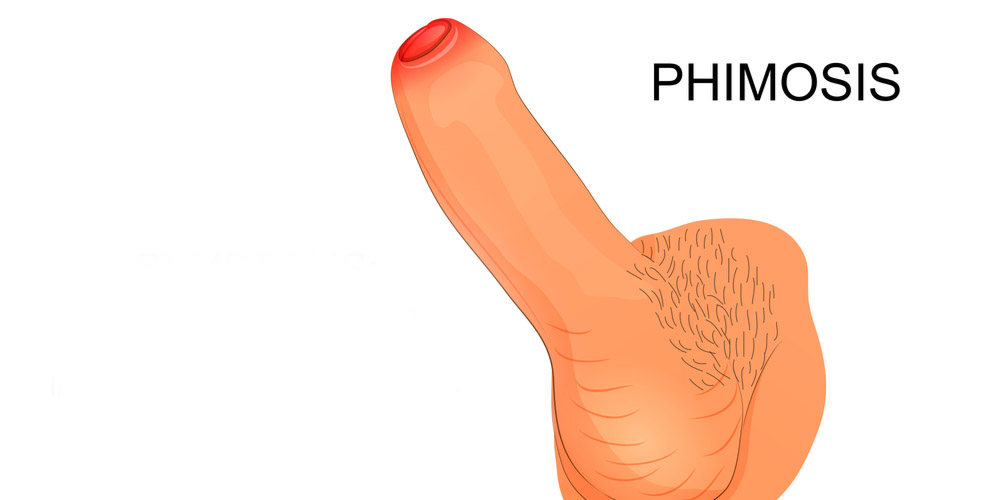![]() Views: 12,725
Views: 12,725
Why Should Phimosis Be Treated?
Phimosis is a condition in which the foreskin of the penis becomes too tight. The tight foreskin does not easily retract over the glans penis. Skin condi...
tions like eczema, psoriasis, etc. may also contribute to the development of phimosis in males. . Read moreDedicated Support at Every Step!
Our Doctors are available 24 hours a day, 7 days a week to help you!
Fact: When a male is born with a tight foreskin (physiological phimosis), in 90% of such cases the issue resolves by the time they reach the age of 16-17. But, the condition has to be treated if phimosis still persists after that.
A man suffering from phimosis symptoms such as swelling, redness, itching, and soreness of the penis. Hence, it causes much pain and discomfort when the male tries to retract the foreskin. In such a case, the chances of scarring of the foreskin are quite high. This scarring makes the condition of phimosis grow severe and more painful. Phimosis may also cause pain during urination and erections. Therefore, it is wise to treat phimosis timely to avoid further problems it can lead to.
Table of Contents
Stretching exercises for phimosis can also help
gently trying to stretch the foreskin every day, especially while bathing helps a lot. Bathing with warm water is the best option. The warm water helps in the loosening of the foreskin. Stretching exercise for phimosis shows results in 2-3 months. Also, remember to not stretch the foreskin in a harsh manner, otherwise, it can result in a tear or scarring.

Treatments for Phimosis
If you have phimosis, don’t worry much. Phimosis is curable and can be treated effectively. If phimosis in your case is not very serious, good hygiene practices can prove to be very effective in providing relief from the condition. However, indulging in self-medication is not the right choice. Medicines for phimosis are available in Ayurveda, Homoeopathy as well as Allopathy. You should start the medication just how they suggest the dosage to be
Ayurvedic treatment for phimosis
Ayurveda prescribes some herbal oils which can help in loosening of the foreskin and help in retraction. So, you can get in touch with an Ayurveda expert rather than indulging in self-medication.(Also Read: How To Treat Phimosis Naturally? )
Homeopathic treatment for phimosis
In homeopathy, medicines like Apis Mellifica, Caladium, Merc Sol, Cantharis, etc. are prescribed. The homeopathic treatment helps in getting relief from pain, burning sensation, itchiness, and redness that phimosis causes.

Allopathy treatment for phimosis
In Allopathy, medicines like Hyaluronidase and Hydrocortisone prove effective in providing symptomatic relief. Your doctor may also prescribe some antibiotics and steroid creams or ointments although these treatments may not be permanent.
If the above-mentioned treatments do not provide relief or if the condition of phimosis reoccurs, undergoing circumcision becomes necessary.
Also Read: Does Phimosis Cause Trouble In Masturbating?
No Cost EMI, Hassle-free Insurance Approval
MBBS, Diploma in Radio Diagnosis & MD-TB & Respiratory Diseases
FREEConsultation Fee
Circumcision for phimosis
There is nothing serious to fret about modern circumcision. Circumcision is the procedure to surgically remove the foreskin of the penis. Conventional circumcision involves the removal of the foreskin using slits and incision. The conventional procedure of circumcision used to be quite complex, painful with a long downtime full of worries. But with the advancement of technology, procedures like ZSR Circumcision, laser circumcision has developed, which are comparatively much easier. (Also read: Pros and cons of circumcision)

In laser circumcision, a high-intensity laser beam is used to remove the foreskin from the penis. The procedure of laser circumcision is minimally invasive. The laser beam acts upon only the penile region and does not affect any other tissues. The patient remains under the effect of anesthesia (general or local anesthesia) during the procedure. Laser circumcision does not involve any big incisions and inflicts minimal pain. This advanced laser-based circumcision offers speedy recovery to the patient. Another major USP of laser circumcision is that it is a daycare procedure that allows the patient to be discharged on the same day.
Other benefits of laser circumcision are:
- Procedure time- 15 minutes
- No bleeding
- Minimally-invasive procedure
- No side effects
- Zero risk of infections
- No risk of recurrence of phimosis
- Minimal swelling and pain after the procedure
- Medically advanced procedure
Thus, circumcision is the most effective treatment for phimosis when no other treatment provides a permanent solution. It is certainly simpler and more effective in comparison to the conventional circumcision to treat phimosis.
Let’s now look at some of the complications that can arise if you do not treat phimosis:
Paraphimosis
Paraphimosis is a condition in which the retracted foreskin of the penis cannot be pulled back to its original position to cover the glans penis. It is an emergency urological condition as it may cause an obstruction in blood flow to the glans penis resulting in the death of tissues. (Also Read: Paraphimosis Treatment)
Balanitis
Balanitis is a condition in which the swelling occurs on the glans penis (head of the penis). It is a severe complication that can arise if you leave phimosis untreated. Balanitis causes a lot of discomfort like itchiness, soreness, and redness in the penis. Furthermore, thick fluid starts building that adds up to the discomfort. (Also read: Balanitis Treatment)
Balanoposthitis
In balanoposthitis, inflammation occurs in both the glans penis and the foreskin of the penis. It causes irritation, pain, burning sensation and unusual discharge from the penis. In some cases, skin erosions or lesions can also occur. Balanoposthitis may even cause difficulty during urination and sexual activities. (Also Read: Balanoposthitis Treatment)
Obstruction of the Urinary Stream
Phimosis causes obstruction of the urinary stream leading to an inability to empty the bladder. In some cases, traces of blood also come out along with the urine. This obstruction to the urinary stream due to phimosis increases the risks of urinary tract infections. (Also Read: How Does A Male Get A Urinary Tract Infection? )
Penile Cancer
This is a rare complication that can arise due to phimosis. Phimosis increases the chances of cancer on the skin of the penis or within the penis. According to doctors, men with tight foreskin are twice at risk of developing penile cancer than those who are circumcised. (Also Read: Frenuloplasty Surgery)
Permanent damage to the penis:
Untreated phimosis and paraphimosis may lead to conditions like gangrene and a decrease in the blood flow to the penis. This can lead to permanent damage to the penis. In such a condition, the doctor may be required to surgically remove the penis.
Therefore, to keep away from any of these complications, consult a doctor as soon as the symptoms of phimosis appear. You don’t have to worry about the treatment of phimosis, just seek immediate medical help.
Also Read:
- Which Circumcision Technique Is Better?
- Can Circumcision Make You Last Longer?
- Circumcised or Uncircumcised? How does it feel to a woman?
- Foreskin infection treatment
FAQs
Phimosis may not always be a serious problem. In some cases, it resolves on its own after some time (physiological phimosis). But if the condition keeps on worsening and causes inflammation (pathological phimosis), immediately consulting a specialist is the right approach. Delaying seeking medical help in such cases of phimosis can have serious impacts.
It is possible to have sex with phimosis, but there are high chances that it will uncomfortable, painful, and unpleasant. It may also result in the tearing of the foreskin, thus you must use lubricant while having sex
The surgical procedure of removing the foreskin or the prepuce from the penis, called circumcision is the fastest way to get rid of phimosis. Men suffering from phimosis these days choose to laser circumcision over the complex open surgery.
The advanced modern procedures of circumcision are absolutely safe. The chances of complications and side-effects used to be associated with the open circumcision. For procedures like ZSR and laser circumcision, the success rate is 100% with the nil chances of any post-operative complications.
Though the need is rare, a surgical procedure called 'foreskin restoration' is used to reverse circumcision. In this procedure, the surgeon stretches the skin of the penis to cover the head Thus making it look and function just like the prepuce.









